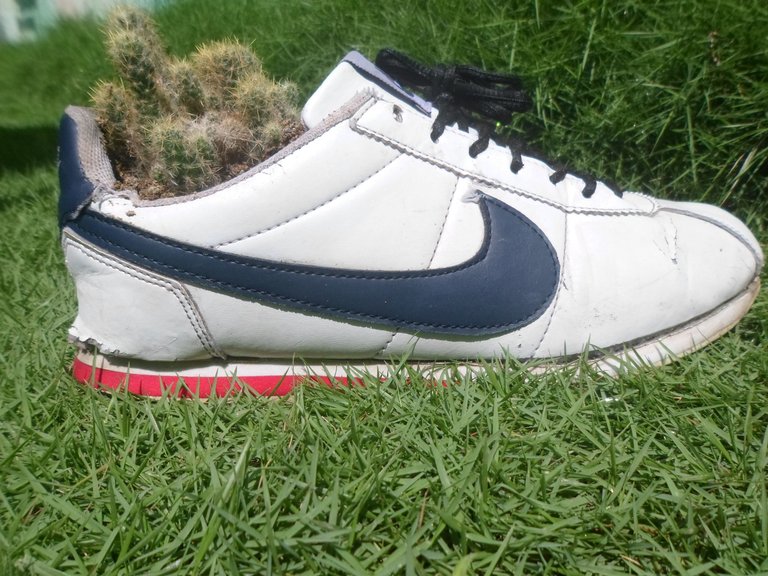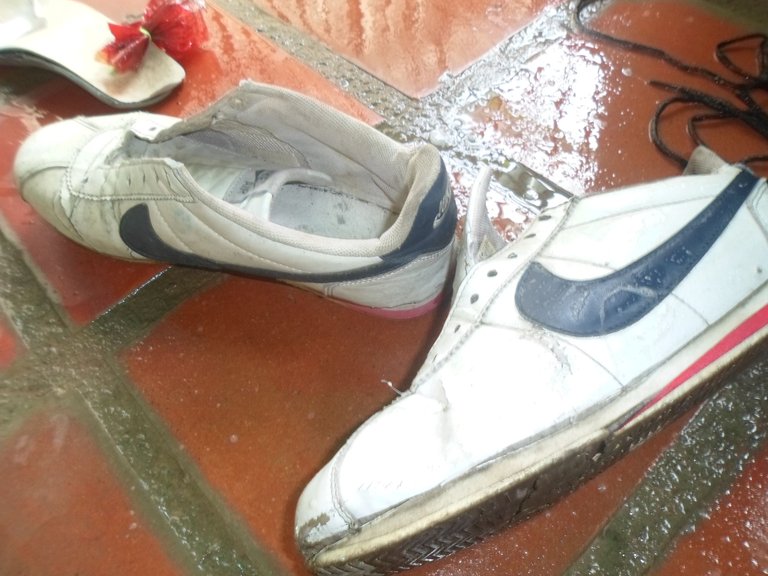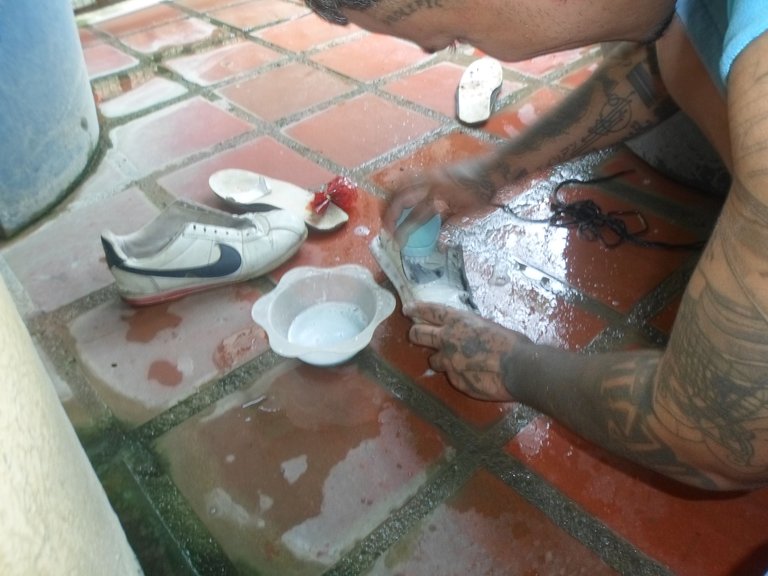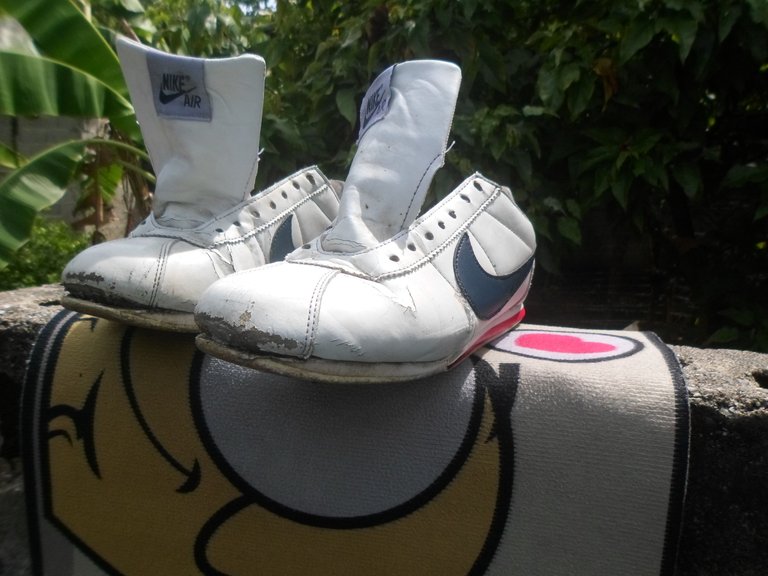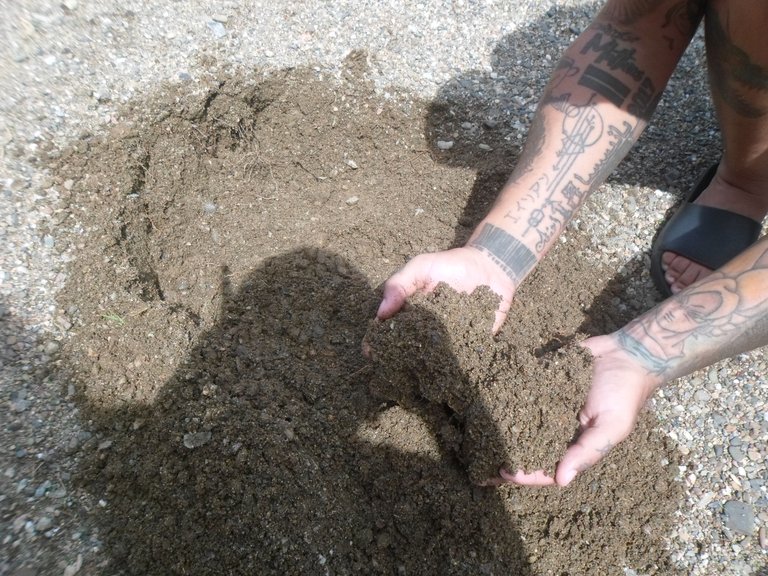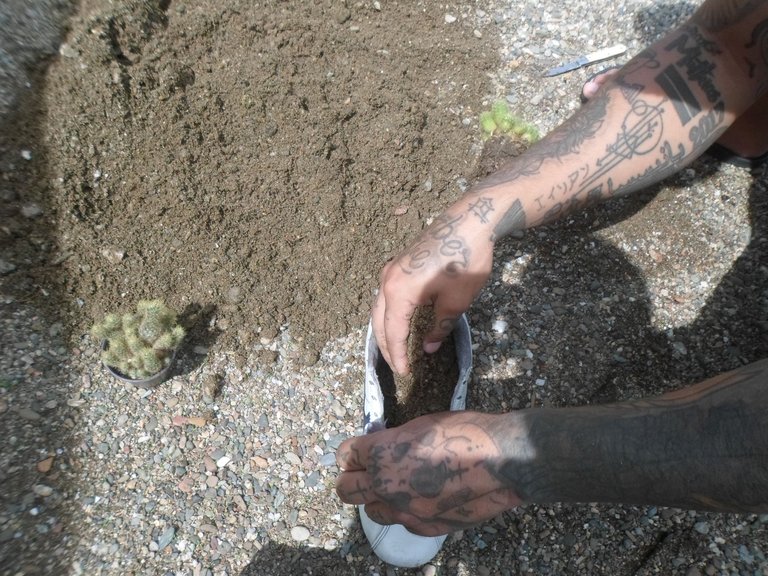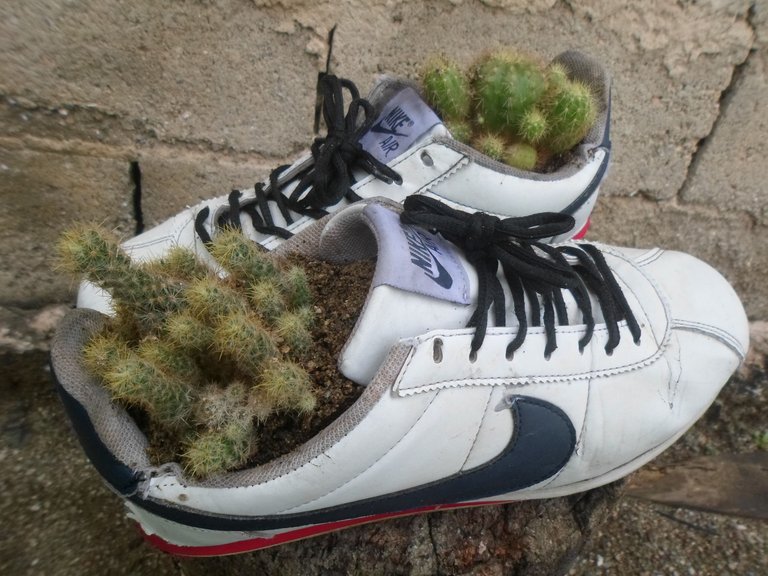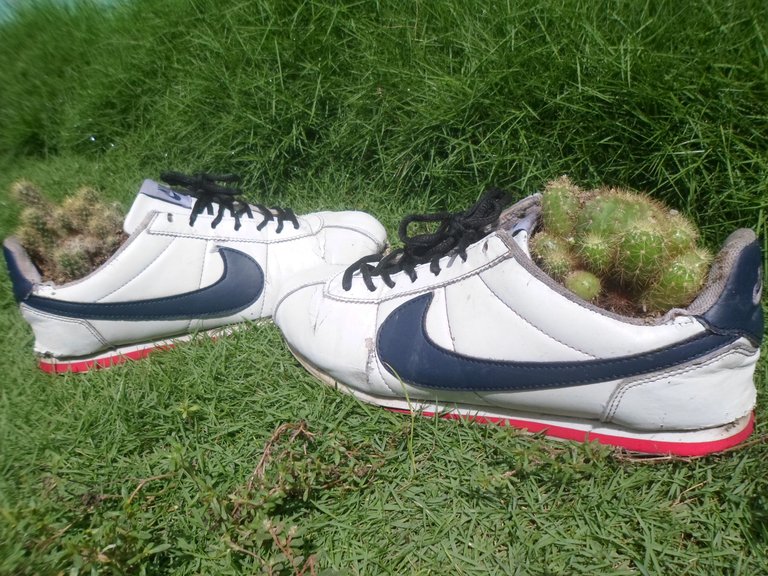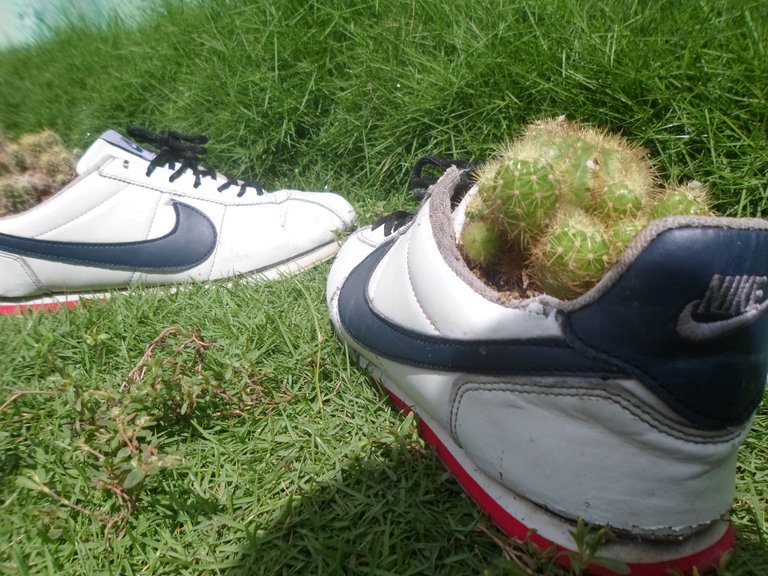Holaaa amigos y amigas de esta maravillosa comunidad.. En un día normal y calmado, se me ocurrió una brillante idea, el cual fue trasplantar mis adorados cactus para unos zapatos muy viejos pero clásicos conocidos como los Nike Cortez
Hello friends and friends of this wonderful community... On a normal and calm day, I came up with a brilliant idea, which was to transplant my beloved cactus for some very old but classic shoes known as the Nike Cortez.
Pensé que se verían muy lindos y únicos. Además que siempre me ha gustado marcar una diferencia y más si se trata de reciclaje para un mundo mejor y ecológico, sé que se estarán preguntando el porq decidí elegir el preciso modelo de zapatos ps les explicaré breve el significado que tiene los Nike Cortez en la selva de cemento a lo que llamamos calle.. Los Cortez fueron los primeros tenis para correr de Nike que dejaron ver el genio del diseño de Bill Bowerman, cofundador de Nike y legendario entrenador de atletismo. Él siempre buscaba que sus atletas desataran su mayor potencial y mejoraran su capacidad de correr. Los Cortez se derivaron de muchas versiones de prototipos, hasta que finalmente iniciaron una revolución en los tenis para correr.
I thought they would look very cute and unique. Besides that I have always liked to make a difference and more if it is about recycling for a better and ecological world, I know you are wondering why I decided to choose the precise model of shoes ps I will explain briefly the meaning of the Nike Cortez in the concrete jungle that we call street... The Cortez were Nike's first running shoes that showcased the design genius of Bill Bowerman, Nike's co-founder and legendary athletic trainer. He was always looking for his athletes to unleash their greatest potential and improve their running ability. The Cortez derived from many prototype versions, until it finally started a revolution in running shoes.
Cuando se hizo el lanzamiento de los Cortez a finales de los años 60, ofrecían una amortiguación hasta entonces desconocida para los corredores de fondo estadounidenses. Se debió a que los Cortez fueron los primeros tenis para correr en los que se combinaron una entresuela de largo completo con una capa de goma esponjosa justo debajo de la parte superior. Los Cortez no solo se convirtieron en los tenis para correr más vendidos de Nike, sino que la nueva combinación de amortiguación también se convirtió en la norma del sector; de este modo, la planta del pie tuvo mejor amortiguación para absorber impactos y se cambió la historia del calzado.
When the Cortez was released in the late 1960s, it offered cushioning previously unknown to American distance runners. It was because the Cortez was the first running shoe to combine a full-length midsole with a layer of sponge rubber just under the upper. Not only did the Cortez become Nike's best-selling running shoe, but the new cushioning combination also became the industry standard, giving the sole better cushioning to absorb shock and changing the history of footwear.
pero lo que realmente ocultaban estas zapatillas era esto.. Los emblemáticos tenis lanzados al mercado en 1972 son toda una institución dentro de la particular estética que identifica a los pandilleros de la MS-13. Tanto que en los tiempos de Trump, cuando han arreciado las políticas contra ellos, están abandonándolos para no delatarse.
but what these sneakers were really hiding was this... The iconic sneakers, launched in 1972, are an institution within the particular aesthetic that identifies MS-13 gang members. So much so that in the times of Trump, when the policies against them have intensified, they are abandoning them so as not to give themselves away.
"Manténganse alejados de los tenis Nike Cortez. Vestidos de esa manera el enemigo puede verlos, la policía puede arrestarlos y ¡boom! de vuelta a El Salvador. Para vivir una gran vida en Estados Unidos uno debe ser humilde, ya sabes, para evitar ser detectado".
Estas instrucciones específicas para evitar el uso de los famosos tenis lanzados al mercado en Los Ángeles en 1972 las da el líder pandillero de la MS-13 Edwin Manica Flores en una conversación teléfonica con un compañero de pandilla de Richmond, Estados Unidos y fueron grabadas por el FBI, que interceptaba su teléfono desde 2015.
Esa llamada es hoy usada como una de las mayores pruebas para inculpar al pandillero, encarcelado en El Salvador, por cargos de conspiración para crimen organizado. Además, se ha convertido en una fiel evidencia de la estrecha relación que ha tejido la pandilla del MS-13 con este modelo de tenis de lona con el emblemático símbolo de Nike en el costado.
Idóneas para correr, ideales para las pandillas
"Las Nike Cortez, que derivan su nombre del conquistador español que sometió a Moctezuma, Hernán Cortés, fueron las primeras zapatillas de deporte todoterreno realmente cómodas que aparecieron en el mercado. Eran resbaladizas y ligeras, lo que las hacía ideales para correr y por lo que pronto se convirtieron en la zapatilla adoptada por los pandilleros mexicanos y otras pandillas de la costa oeste de Estados Unidos", explica a Univision Noticias Ron 'Cook' Barrett, un experto en prevención de pandillas que ha trabajado con jóvenes en el estado de Nueva York desde 1999.
La Guerra Civil en el Salvador de la década de los 80 obligó a muchos jóvenes y ex combatientes a huir a los EEUU, especialmente a Los Angeles, California, y muchos inmigrantes salvadoreños se agruparon para protegerse de las pandillas coreanas, chicanas y afroamericanas que estaban presentes en la zona, fundando ellos mismos sus propios grupos juveniles y delincuenciales y replicando con su estética la manera de crear una identidad que los diferenciara.
“Stay away from Nike Cortez sneakers. Dressed like that the enemy can see you, the police can arrest you and boom, back to El Salvador. To live a great life in the United States one must be humble, you know, to avoid detection.”
These specific instructions to avoid wearing the famous tennis shoes launched in Los Angeles in 1972 are given by MS-13 gang leader Edwin Manica Flores in a phone conversation with a fellow gang member in Richmond, United States and were recorded by the FBI, which had been intercepting his phone since 2015.
That call is today used as one of the most important pieces of evidence to indict the gang member, who is imprisoned in El Salvador, on charges of conspiracy to commit organized crime. In addition, it has become faithful evidence of the close relationship that the MS-13 gang has woven with this model of canvas sneakers with the emblematic Nike symbol on the side.
Ideal for running, ideal for gangs.
“The Nike Cortez, named after the Spanish conquistador who subdued Montezuma, Hernán Cortés, was the first truly comfortable all-terrain running shoe to hit the market. They were slippery and lightweight, which made them ideal for running and so they soon became the shoe of choice for Mexican gang members and other gangs on the West Coast of the United States,” Ron ‘Cook’ Barrett, a gang prevention expert who has worked with youth in New York state since 1999, tells Univision Noticias.
The Civil War in El Salvador in the 1980s forced many young people and ex-combatants to flee to the U.S., especially to Los Angeles, California, and many Salvadoran immigrants banded together to protect themselves from the Korean, Chicano and African-American gangs that were present in the area, founding their own youth and criminal groups and replicating their own aesthetics to create an identity that would set them apart.
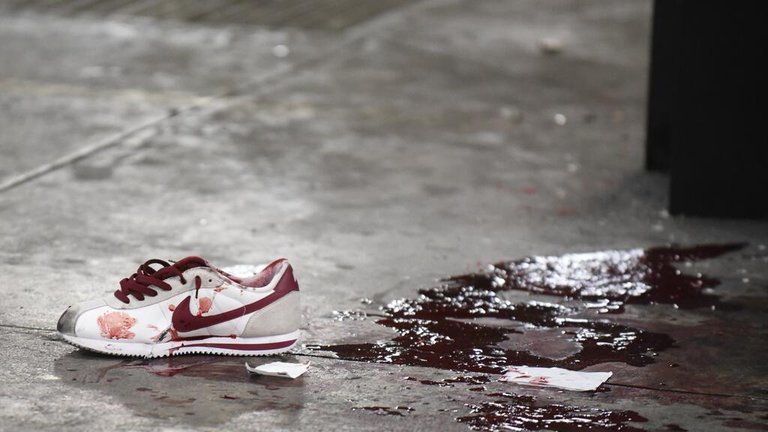
The shoe and blood of a wounded person remain after members of the "Mara Salvatrucha" gang were attacked while they were under custody in court, in Guatemala City on September 30, 2015. A gang member was killed and two others wounded by rival gangsters, while they were held under custody in a special jail located in the basement of the Supreme Court building. AFP PHOTO JOHAN ORDONEZ (Photo credit should read JOHAN ORDONEZ/AFP/Getty Images) Crédito: JOHAN ORDONEZ/AFP/Getty Images
"En realidad, los primeros pandilleros ni siquiera llevaban tenis, usaban unos zapatos formales de la marca Stacy Adams", explica Alex Sánchez, expandillero de los Mara Salvatrucha y fundador de la organización para ayudar a ex miembros de estas pandillas a reintegrarse a la sociedad, Homies Unidos, en Los Angeles, quien recuerda que el estilo 'Pachuco', hecho de traje sastre formal y pantalones a la cintura que usaron las cuadrillas latinas en Estados Unidos en la década de los 50 "fue reemplazada en los años 80 por pantalones kakis, cabezas rapadas, camisas de cuadros abotonadas solo arriba y tenis. Una estética propia de los Cholos que luego sería replicada por miembros de la Mara Salvatrucha Stoner, que abandonaron su look metalero y de Heavy metal".
“Actually, the first gang members didn't even wear tennis shoes, they wore Stacy Adams formal shoes,” explains Alex Sanchez, a Mara Salvatrucha gang member and founder of the organization to help former gang members reintegrate into society, Homies Unidos, in Los Angeles, who recalls that the 'Pachuco' style, made up of formal tailored suits and slacks worn by Latino gangs in the United States in the 1950s “was replaced in the 1980s by khaki pants, shaved heads, plaid shirts buttoned only at the top, and tennis shoes. An aesthetic typical of the Cholos that would later be replicated by members of the Mara Salvatrucha Stoner, who abandoned their metal and heavy metal look”.
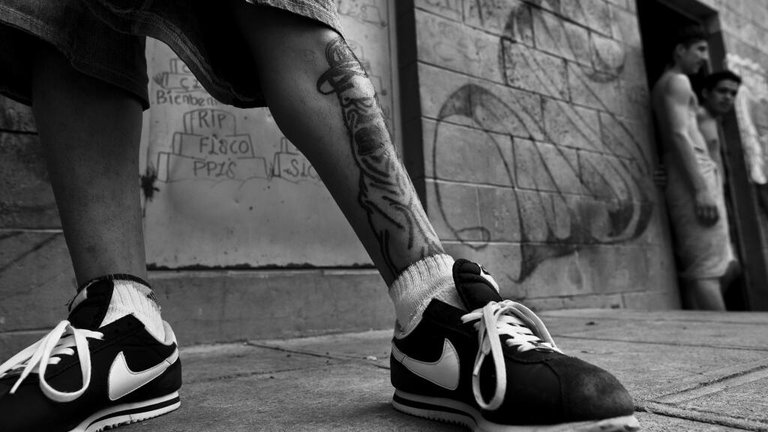
TONACATEPEQUE, EL SALVADOR - MAY 18: A member of the Mara Salvatrucha gang (MS-13) stands in front of his cell in the prison of Tonacatepeque, on May 18, 2011 in Tonacatepeque, El Salvador. During the last two decades, Central America has become the deadliest region in the world that is not at war. According to the UN statistics, more people per capita were killed in El Salvador than in Iraq, in recent years. Due to the criminal activities of Mara Salvatrucha (MS-13) and 18th Street Gang (M-18), the two major street gangs in El Salvador, the country has fallen into the spiral of fear, violence and death. Thousands of Mara gang members, both on the streets or in the overcrowded prisons, organize and run extortions, distribution of drugs and kidnappings. Tattooed armed young men, mainly from the poorest neighborhoods, fight unmerciful turf battles with their coevals from the rival gang, balancing between life and death every day. Twenty years after the devastating civil war, a social war has paralyzed the nation of El Salvador. (Photo by Jan Sochor/Latincontent/Getty Images) Crédito: Jan Sochor/CON/LatinContent/Getty Images
Desde entonces, los tenis Nike Cortez se convirtieron en un elemento fundamental en la estética pandillera de la MS-13. Fueron un mecanismo callado y, en principio, secreto para identificar quién hacía parte del grupo y quien no. Caminar por ciertos barrios de la Costa Oeste de Estados Unidos o de Honduras y El Salvador podía ser riesgoso si se llevaba la marca de tenis equivocada. Las fronteras invisibles creadas por estos grupos criminales empezaron a hacer respetar un estricto código de vestimenta y las noticias empezaron a poner en evidencia cómo si alguien quebraba estas normas o las irrespetaba por desconocerlas podía pagar con su vida.
"Los tenis proveen a estos jóvenes un estatus. Tener ese tipo de zapatos les hace decir 'no cualquiera los tiene', y les permite cierta señal de clase dentro del grupo", explica José Miguel Cruz, director del departamento de Estudios Latinoamericanos y del Caribe de la Universidad Internacional de la Florida, quien lleva más 20 años investigando a las pandillas MS-13 y Barrio 18.
La importancia de estos tenis se hizo muy evidente durante la tregua entre pandillas que se dio entre 2012 y 2013 en El Salvador para detener los homicidios y el reclutamiento forzado de miembros. "Cuando los reos de pandillas tuvieron la oportunidad de obtener ciertos beneficios en las cárceles, una de las cosas que más pedían eran sus Nike Cortez, que llevaban con las medias blancas hasta arriba, muy limpios, inmaculados. Estaban en shorts y camisetas, pero si veías sus piernas se veían iguales todos", añade Cruz.
La devoción de los pandilleros por un tipo de tenis en concreto no solo se registró en las cárceles de El Salvador y no solo estuvo atada a este particular modelo de Nike tan popular en Los Ángeles.
En 2008, el departamento Correccional de la Ciudad de Nueva York prohibió el uso de tenis personales a los presos para evitar peleas. Se habían dado cuenta de que cada grupo había creado un complejo código alrededor de los zapatos que llevaban, uno que les permitía identificar de manera no verbal quién hacía parte de qué grupo y quién corría inminente peligro por llevar unos tenis contrarios.
Since then, Nike Cortez tennis shoes have become a fundamental element in the gang aesthetic of the MS-13. They were a quiet and, in principle, secret mechanism to identify who was part of the group and who was not. Walking through certain neighborhoods on the West Coast of the United States or in Honduras and El Salvador could be risky if you wore the wrong brand of sneakers. The invisible borders created by these criminal groups began to enforce a strict dress code, and the news began to highlight how anyone who broke these rules or disrespected them by disregarding them could pay with their life.
“Sneakers provide these young people with status. Having those kinds of shoes makes them say 'not just anyone has them,' and allows them a certain sign of class within the group,” explains José Miguel Cruz, director of the Latin American and Caribbean Studies department at Florida International University, who has been researching the MS-13 and Barrio 18 gangs for more than 20 years.
The importance of these sneakers became very evident during the gang truce that took place between 2012 and 2013 in El Salvador to stop homicides and the forced recruitment of members.“When gang inmates had the opportunity to get certain benefits in the prisons, one of the things they asked for the most were their Nike Cortez, which they wore with white socks all the way up, very clean, immaculate.They were in shorts and T-shirts, but if you saw their legs they all looked the same,” adds Cruz.
The gang members' devotion to a particular type of tennis shoe was not only registered in the prisons of El Salvador and was not only tied to this particular Nike model so popular in Los Angeles.
In 2008, the New York City Department of Corrections banned the use of personal sneakers by inmates to prevent fights.They had realized that each group had created a complex code around the shoes they wore, one that allowed them to nonverbally identify who was part of which group and who was in imminent danger for wearing opposing sneakers.
Ya Sabiendo todo el significado sobre estos zapatos, quise verlos desde otro punto de vista al crear de lo bueno al mal uso por humanos desequilibrados a la estabilidad de un mejor mundo lleno de cultivaciones a mejores valores sobre todas las cosas.
Already knowing all the meaning about these shoes, I wanted to see them from another point of view by creating from the good to the bad use by unbalanced humans to the stability of a better world full of cultivations to better values above all things.
Espero que les allá gustado mucho, por aquí dejaré cada paso por paso de mi idea para mis cactus.
I hope you liked it a lot, I will leave here every step by step of my idea for my cactus.
